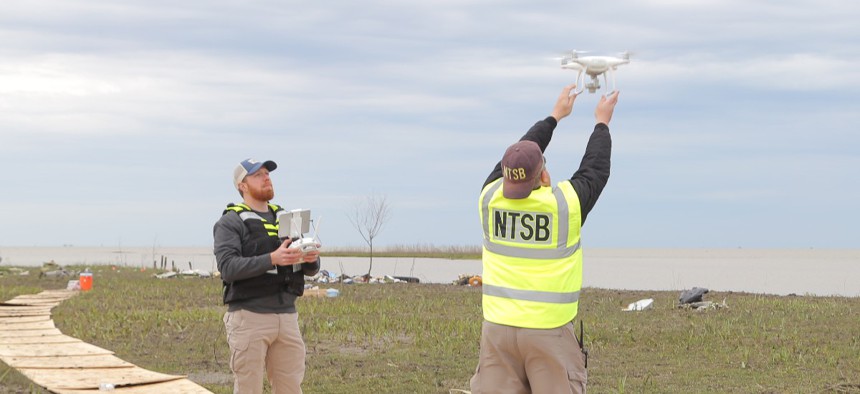National Transportation Safety Board Wants To Expand Drone Operations

In this photo taken Feb. 25, 2019, NTSB investigators launch a drone to survey debris field of the Feb. 23, 2019, cargo jet crash in Texas. NTSB Photo
The transit agency has been using drones to analyze and recreate accidents across all transportation industries.
Federal agencies plan to continue incorporating drone technology into their business operations, with government pilots currently focusing on threading the needle between automation and safety, with the surveillance aircraft.
One agency looking to capitalize on improved drone technology is the National Transportation Safety Board, which has been employing drones to capture footage from accidents among maritime, aircraft and auto transportation systems since 2016.
“We're looking to expand to have more pilots in the agency and more drones, so that we can respond to more of our accident scenes,” Catherine Gagne, an unmanned aircraft system operator within the National Transportation Safety Board’s Office of Aviation Safety said Tuesday.
Speaking during a panel discussion via the Advanced Technology Academic Research Center, Gagne discussed the agency’s core mission of investigating transit accidents and how drones have been part of site documentation for the last six years.
Using photogrammetry software to process photos, video imagery and orthomosaics, drone footage has been a reliable way for investigators to probe an unsafe or treacherous accident site. In other use cases, drones have been able to use existing data from transit methods like helicopters to replicate conditions that led to an aircraft accident and better understand what caused the crash.
Gagne said that her office continues to find new uses for drones, and currently have five pilots to man seven drone aircraft devices.
Since the drones are technically classified as aircraft, Gagne also noted that NTSB has been working to abide by privacy laws that other flight operators have to abide by.
“Anything we gather with the drone is in our public docket anyway and available,” she said. “But you know, we're very careful about what we shoot due to privacy concerns.”
Amid security precautions, the NTSB has been practicing its automated app to program and control the drones, and additionally work on ensuring pilots can easily regain control of an automated drone.
Given the success of the program so far, Gagne said that the NTSB is looking for more drone pilots.
“The program has proven its worth and we're looking to expand it,” she said.
The NTSB is one of the agencies that has employed drones across various work areas. Aside from common use cases seen with the Department of Defense, government bodies, including The U.S. Postal Service, have toyed with innovative ideas on how to expedite package deliveries with drone technology.
Amid the broad interest, the General Services Administration recently restricted the procurement of drones by federal agencies aside from a group of previously approved devices, citing national security concerns.




